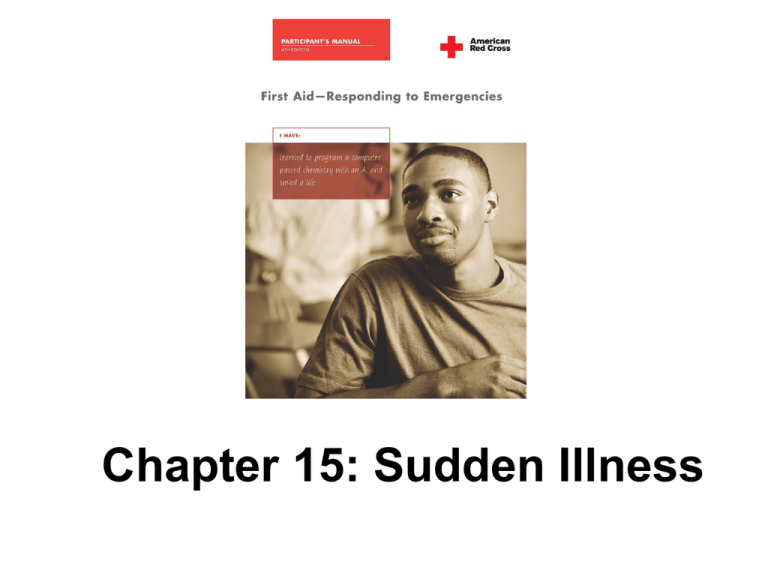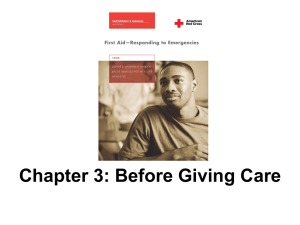
Chapter 15: Sudden Illness
Responding to a Medical Emergency
General signs of sudden illness:
Change in a person’s level of consciousness
Feeling lightheaded, dizzy or weak
Nausea or vomiting
Changes in breathing, circulation, skin temperature, color or
moisture
General care for sudden illnesses include—
Do no further harm.
Monitor breathing and consciousness.
Help the victim rest in the most comfortable position.
Keep the victim from getting chilled or overheated.
Reassure the victim.
Give any specific care needed.
292
AMERICAN RED CROSS FIRST AID–RESPONDING TO EMERGENCIES FOURTH EDITION
Copyright © 2005 by The American National Red Cross
All rights reserved.
Sudden Illness
Sudden illness can be—
Acute.
Chronic.
Common sudden illnesses include—
Fainting.
Diabetic emergencies.
Seizures.
Stroke.
Poisoning.
Heart attack.
Shock.
293
AMERICAN RED CROSS FIRST AID–RESPONDING TO EMERGENCIES FOURTH EDITION
Copyright © 2005 by The American National Red Cross
All rights reserved.
Fainting
Partial or complete loss of consciousness caused by a temporary
reduction of blood flow to the brain.
The victim will commonly display shock-like signals, such as—
Cool, pale, moist skin.
Nausea.
Numbness or tingling in the fingers and toes.
Additional signals that may precede fainting include—
Sweating.
Vomiting.
Distortion or dimming of vision.
Head or abdominal pain.
294
AMERICAN RED CROSS FIRST AID–RESPONDING TO EMERGENCIES FOURTH EDITION
Copyright © 2005 by The American National Red Cross
All rights reserved.
Care for Fainting
General care for sudden illness:
Position the victim on the back on a flat surface. Elevate the
legs about 12 inches.
Loosen any restrictive clothing.
Check for any other life-threatening and non-life-threatening
conditions.
Do not give the victim anything to eat or drink.
Do not splash the victim with water or slap his or her face.
As long as the fainting victim recovers quickly and has not
lasting signals, you may or may not need to call 9-1-1 or the
local emergency number.
295
AMERICAN RED CROSS FIRST AID–RESPONDING TO EMERGENCIES FOURTH EDITION
Copyright © 2005 by The American National Red Cross
All rights reserved.
Diabetes Mellitus
A condition in which the body does not produce enough insulin or does
not use insulin effectively is called diabetes mellitus.
Type I
Type II
Hyperglycemia
Hypoglycemia
296
AMERICAN RED CROSS FIRST AID–RESPONDING TO EMERGENCIES FOURTH EDITION
Copyright © 2005 by The American National Red Cross
All rights reserved.
Signs of Diabetic Emergency
Changes in consciousness, including dizziness, drowsiness and
confusion.
Irregular breathing.
Abnormal pulse (rapid or weak).
Feeling or looking ill.
297
AMERICAN RED CROSS FIRST AID–RESPONDING TO EMERGENCIES FOURTH EDITION
Copyright © 2005 by The American National Red Cross
All rights reserved.
Care for a Diabetic Emergency
Check and care for any life-threatening conditions.
If conscious:
Check for non-life-threatening conditions.
Look for a medical alert tag or ask the victim if he or she has
diabetes.
give sugar in the form of fruit juice, candy or a non-diet soft drink.
If unconscious:
Call 9-1-1 or the local emergency number immediately.
Do not give the victim anything by mouth.
Monitor signs of circulation and breathing.
Keep him or her from getting overheated or chilled.
298
AMERICAN RED CROSS FIRST AID–RESPONDING TO EMERGENCIES FOURTH EDITION
Copyright © 2005 by The American National Red Cross
All rights reserved.
Seizures
299
Caused by an acute or chronic condition.
Before a seizure occurs, the victim may experience an aura
Seizures can range from mild blackouts to sudden, uncontrolled muscular contractions that
can last several minutes.
Febrile seizures
Common in children under 5 and can be triggered by ear, throat, or digestive system
infections or a fever of over 102°F (38.9°).
Signs:
A sudden rise in body temperature
A change in the level of consciousness
Rhythmic jerking of the head and limbs
Urinating or defecating
Confusion
Drowsiness
Crying out
Becoming rigid
Holding the breath
Upward rolling of the eyes
AMERICAN RED CROSS FIRST AID–RESPONDING TO EMERGENCIES FOURTH EDITION
Copyright © 2005 by The American National Red Cross
All rights reserved.
Care for a Seizure
Do not try to hold or restrain the victim.
Protect the victim from injury and maintain an open airway.
Remove nearby objects that could cause injury.
After the seizure, position him or her on one side so that fluid can
drain from the mouth.
Check for life-threatening conditions.
Stay with the victim until he or she is fully conscious and aware of
his or her surroundings.
Call 9-1-1 or the local emergency number, if necessary.
300
AMERICAN RED CROSS FIRST AID–RESPONDING TO EMERGENCIES FOURTH EDITION
Copyright © 2005 by The American National Red Cross
All rights reserved.
Stroke
A disruption of blood flow to a part of the brain, resulting in
permanent damage to brain tissue.
Caused by a blood clot, aneurysm or atherosclerosis.
A transient ischemic attack (TIA) -
301
AMERICAN RED CROSS FIRST AID–RESPONDING TO EMERGENCIES FOURTH EDITION
Copyright © 2005 by The American National Red Cross
All rights reserved.
Reducing Risk of Stroke and Other
Cardiovascular Diseases
Control blood pressure
Not smoking
Eat a healthy diet
Exercise regularly
Control diabetes
302
AMERICAN RED CROSS FIRST AID–RESPONDING TO EMERGENCIES FOURTH EDITION
Copyright © 2005 by The American National Red Cross
All rights reserved.
Signs of Stroke
Appearing or feeling ill, or displaying abnormal behavior
Sudden weakness or numbness of the face, arm or leg, often on only
one side of the body
Difficulty speaking or being understood
Blurred or dimmed vision
Pupils of unequal size
Sudden severe headache
Dizziness
Confusion
Change in mood
Ringing in the ears
Loss of consciousness
Loss of bowel or bladder control
303
AMERICAN RED CROSS FIRST AID–RESPONDING TO EMERGENCIES FOURTH EDITION
Copyright © 2005 by The American National Red Cross
All rights reserved.
Care for a Stroke
Care for life-threatening conditions.
Call 9-1-1 or the local emergency number immediately.
Position him or her on one side (affected or paralyzed side down)
to allow fluids to drain.
Stay with the victim and check his or her breathing and signs of
circulation.
If the victim is conscious—
Check for non-life-threatening conditions.
Offer comfort and reassurance.
Have the victim rest in a comfortable position.
304
AMERICAN RED CROSS FIRST AID–RESPONDING TO EMERGENCIES FOURTH EDITION
Copyright © 2005 by The American National Red Cross
All rights reserved.


